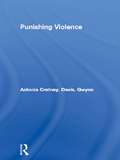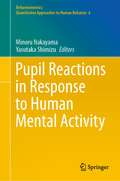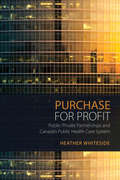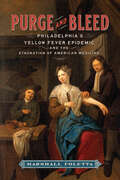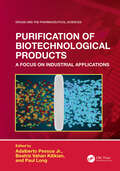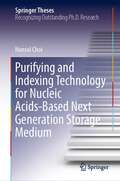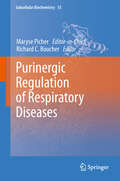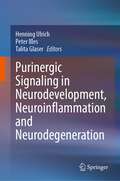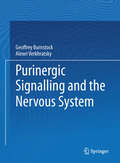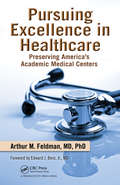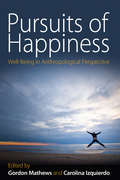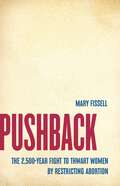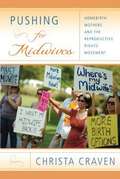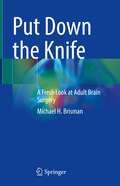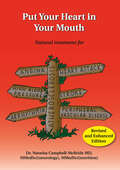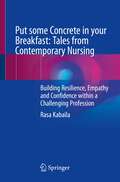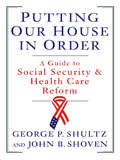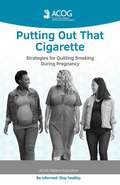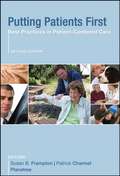- Table View
- List View
Punishing Violence
by Gwynn Davis Antonia CretneyIt is a common perception that violent crime is on the increase and social surveys record a growing fear of victimisation among the public. Yet not all violence is criminalised, and much criminal violence still goes unreported. Punishing Violence examines the series of decisions - by victims, police officers, prosecutors and courts - which determine whether or not violent behaviour is criminalised. Antonia Cretney and Gwynn Davis examine the relationships underpinning violence, the reasons for violent acts and the factors militating against successful court prosecutions. In doing so, they provide an authoritative account of the reality of assault and identify a serious dislocation between the purposes of victims and the purposes of the justice system in the treatment of violent crime.
Punto de Equilibrio
by J. G. JuradoEn esta brillante novela, en la que el suspenso nunca termina, un renombrado neurocirujano se ve forzado a decidir entre terminar la vida de la persona más importante de los Estados Unidos o garantizar la terrible muerte de su propia hija.No soy un santo, ni un mártir, tampoco un terrorista, un maníaco, ni asesino... Soy un padre. Esta es mi historia. El Dr. David Evans es un reconocido neurocirujano en un hospital en Washington, DC, y un padre devoto. Pero pronto tendrá que enfrentarse al peor de los dilemas: si su siguiente paciente, que necesita una cirugía en el cerebro, sale del quirófano vivo, su pequeña hija morirá en las manos del despiadado psicópata que la secuestró, y él tendrá que ser testigo. En el transcurso de las cincuenta y cinco horas frenéticas para llegar al momento de decisión en la sala de cirugía, el Dr. Evans tendrá que encontrar a su enemigo y hallar una salida para esta abominable pesadilla. Y, ¿qué tan lejos llegará para salvara a su hija? "Una montaña rusa de miedo y suspenso sin precedentes en la literatura moderna" (Katherine Neville, autora bestseller del New York Times), Punto de Equilibrio lo mantendrá al borde de su asiento con escenas de acción rápidas y emoción cruda mientras un hombre se enfrenta a un imposible dilema moral que puede cambiar el curso de la historia.
Pupil Reactions in Response to Human Mental Activity (Behaviormetrics: Quantitative Approaches to Human Behavior #6)
by Minoru Nakayama Yasutaka ShimizuThis book focuses on a development for assessing mental changes using eye pupil reactions, namely extracting emotional change from the response to evaluate the viewer's interest in visual information. The pupil of the eye reacts to both brightness and emotional state, including interest, enjoyment, and mental workload. Because pupillary change is a biological signal, various artifacts influence measurements of eye images. Technical procedures are required to extract mental activities from pupillary changes, and they are summarized here step by step, although some procedures contain earlier techniques such as analog video processing. This study examines the possibility of estimating the viewer's interest and enjoyment of viewing movies by measuring the dynamic pupillary changes, blinking, and subjective interest responses. In evaluation of pupil size, there was a significant difference in pupil size between the higher and the lower shot for the degree of subject interest response in each kind of movies. The first part of the book shows a pupil reaction model for brightness changes to extract mental activities. Pupil reactions were observed for various visual stimuli in brightness changes. With regard to the characteristics of pupillary changes, a model with a three-layer neural network was developed and the performance was evaluated. Characteristics of pupil reactions during model development are summarized here. The second part examines the possibility of estimating the viewer's interest and enjoyment of television programs by measuring dynamic pupillary changes, blinking, and subjective interest responses. The final part describes a development of estimation model of pupil size for blink artifact. The model development was able to estimate pupillary changes and pupil size while the viewer was blinking and was applied to pupillary changes in viewing television programs.
Purchase for Profit
by Heather WhitesideSince the start of the twenty-first century, Canadian provinces have increasingly begun turning to the private sector to finance and construct large-scale infrastructure projects. From a critical public policy perspective, the danger of these public-private partnerships (P3s) is that they are more than just new ways to deliver public infrastructure. They are neoliberal projects that privatize and corporatize the basis of public services.Analyzing four Canadian P3 hospital projects, Heather Whiteside argues that P3s not only fail to fulfill the promises made by their proponents but also compromise public control of health policy, outcomes, and future plans. Yet, despite these disadvantages, the use of P3s is being normalized and expanded in BC and Ontario through capital planning frameworks and special government agencies that support and encourage P3 projects. Based on extensive interviews with academic experts, union representatives, provincial government decision-makers, and private sector partners, Purchase for Profit will be important for those studying public policy in any of the areas in which P3s are now being adopted.
Purchasing Medical Innovation
by James C. RobinsonInnovation in medical technology generates a remarkable supply of new drugs, devices, and diagnostics that improve health, reduce risks, and extend life. But these technologies are too often used on the wrong patient, in the wrong setting, or at an unaffordable price. The only way to moderate the growth in health care costs without undermining the dynamic of medical innovation is to improve the process of assessing, pricing, prescribing, and using new technologies. Purchasing Medical Innovation analyzes the contemporary revolution in the purchasing of health care technology, with a focus on the roles of the Food and Drug Administration (FDA), Medicare and private health insurers, physicians and hospitals, and consumers themselves. The FDA is more thoroughly assessing product performance under real-world conditions as well as in laboratory settings, accelerating the path to market for breakthroughs while imposing use controls on risky products. Insurers are improving their criteria for coverage and designing payment methods that reward efficiency in the selection of new treatments. Hospitals are aligning adoption of complex supplies and equipment more closely with physicians' preferences for the best treatment for their patients. Consumers are becoming more engaged and financially accountable for their health care choices. This book describes both the strengths and deficiencies of the current system of purchasing and highlights opportunities for buyers, sellers, and users to help improve the value of medical technology: better outcomes at lower cost.
Pure Madness: How Fear Drives the Mental Health System
by Jeremy LaurancePublic alarm for random attacks by mentally ill people is at an all-time high. The brutal killing of Jill Dando, the TV personality, and the assault on George Harrison, the former Beatle, are among the cases which have undermined confidence in the mental health service. Community care is widely seen as a failed policy that has left too many people walking the streets, posing a risk to themselves and a threat to others. The Government has responded with a programme of change billed as the biggest reform in forty years, but will it achieve the 'safe, sound, supportive' service as promised?For Pure Madness, Jeremy Laurance travelled across the country observing the care provided to mentally ill people in Britain today. Based on interviews, visits and case histories, his book reveals a service driven by fear.
Purge and Bleed: Philadelphia's Yellow Fever Epidemic and the Stagnation of American Medicine
by Marshall FolettaExplaining the deadly stasis of American medicine in the nineteenth century The 1793 yellow fever epidemic in Philadelphia was a shock to the system of American medicine—or it should have been. In the decades that followed the most infamous health crisis of the early republic, American doctors by and large failed to move beyond ancient ideas of disease and treatment. The contentiousness of Philadelphia&’s medical community, led by Benjamin Rush, prevented any meaningful advances in response to the outbreak. Marshall Foletta investigates this peculiar dormancy over the course of the long nineteenth century and reveals how little had changed by the time of the 1832 cholera epidemic—leading, he argues, to exhaustion and despair among medical professionals and fatalism among the general public. Only at the end of the century did researchers make the all-important breakthroughs that produced an antidote to yellow fever. This is the story of how received wisdom became dangerously entrenched in the early United States, and the deadly consequences of scientific stagnation and intellectual inertia.
Purification of Biotechnological Products: A Focus on Industrial Applications (ISSN)
by Paul Long Pessoa Jr. Adalberto Beatriz Vahan KilikianThis outstanding text focuses on providing professionals and students working in the pharmaceutical and biotechnology field with the background necessary for developing of a product or process and with the necessary rigor required by federal regulatory agencies in the pharmaceutical industry. The material will enable teachers, lecturers and professors in biotechnology to prepare courses on basic concepts and applications for the purification of biotechnological products of industrial interest. These can be applied in practice, for example, with projects on purification development on an industrial scale or useful unit operations for the development of bioproducts of commercial interest.Features: Purification and development of new bioproducts and improvement of those being produced. Provides a background and concepts on the purification of biomolecules and with an industrial perspective. It allows professionals to understand the entire process of developing a biopharmaceutical or bio-food, from bench to industry in biotechnology; one of the fastest-growing sectors of the economy. It promotes the dissemination of information in a didactic way which is of paramount importance for interdisciplinary fields It enables the reader to follow step-by-step stages of the development of a new biopharmaceutical, and allows the optimization of existing processes.
Purifying Crystals
by Michael GiengerThe essential prerequisite for working with crystals successfully is to understand the most effective methods for cleansing, purifying, and recharging them, as thoroughly discussed and evaluated in this conveniently sized guidebook. Users of crystals for their healing energies will learn how their tools become impure and corrupted as well as how to adequately purify them from foreign energies and information. The instructions are demonstrated through a complete cleansing ceremony that can be used on all crystals, including jewelry. Other topics covered include the external cleaning of jewelry for purely aesthetic purposes and the correct application of crystals for cleansing rooms.
Purifying and Indexing Technology for Nucleic Acids-Based Next Generation Storage Medium (Springer Theses)
by Hansol ChoiThis book introduces novel purification technology for the complex oligonucleotide libraries. Since the concept of synthesizing oligonucleotides (oligos) has been proposed, research fields such as nucleic acid-based therapies (CRISPR-Cas9, DNA/RNA vaccines, RNAi), synthetic biology, protein engineering, and DNA-based data storage have bloomed. The COVID-19 pandemic underscores the potential of nucleic acid-based technologies, such as vaccines or diagnostics. As they emerge as the most promising weapons against the current pandemic, increasing need for highly accessible nucleic acid purification technologies is expected. To meet this demand, an oligo purification technology that can be applied to complex oligo libraries and can purify oligos with single-base resolution is developed. In addition, the purification technology can be applied to highly complex oligo libraries of different lengths, enabling the simultaneous purification of complex oligo libraries with different lengths. The proposed technology can be easily accessed by users and would help accelerate numerous research fields that utilize oligos as fundamental building blocks.
Purinergic Regulation of Respiratory Diseases
by Richard C. Boucher Maryse PicherWe proudly present the first book to integrate all aspects of purinergic signaling in the respiratory system. The first chapters introduce basic notions of purinergic pharmacology and metabolism, which allows readers from all scientific backgrounds to fully grasp the importance of these signaling networks for airway defenses, including mucociliary clearance and inflammatory responses. Then, chapters are devoted to the groundbreaking discovery that chronic respiratory diseases, including asthma, cystic fibrosis and chronic obstructive pulmonary disease (COPD), present specific aberrances in purinergic signaling which essentially drive lung complications. The last chapters describe the animal models used to investigate purinergic signaling in respiratory diseases, and the therapeutic applications developed by the pharmaceutical industry based on receptor agonists/antagonists and metabolic correctors. This highly comprehensive manuscript constitutes an invaluable tool for beginners and experts to follow the rapidly evolving research field of purinergic signaling. Furthermore, the critical analysis of past clinical protocols should facilitate the identification of potent therapeutic targets, and provide a better understanding of the data acquired in current clinical trials.
Purinergic Signaling in Neurodevelopment, Neuroinflammation and Neurodegeneration
by Henning Ulrich Peter Illes Talita GlaserThis volume explores the quickly evolving field of Purinergic signaling, and examines how receptors for ATP and other nucleotides, and receptors for adenosine, act in neuronal transmission, control of synaptic activity, proliferation, differentiation and cell death regulation in the CNS. This book focuses on the participation of purinergic receptors and ectonucleotidases, degrading ATP into adenosine, in embryonic and adult neurogenesis in vitro and in vivo as well as in synaptic transmission and pathophysiology. Further, the chapters discuss varying brain diseases, including Parkinson’s, and Alzheimer’s disease, autism, mood disorders and epilepsy, as well as brain tumors, in the context of purinergic signaling and its clinical aspects. The development of purinergic receptor agonists is also an important issue of this book. This book provides a critical review of the current state of science and will be useful for both scientists and students who are or would like to get involved in this area. Furthermore, this book addresses neuroscientists, physician and professionals from the industry, who would like to update themselves in this exciting and rapidly growing field of neuroscience.
Purinergic Signalling and the Nervous System
by Verkhratsky Alexei Geoffrey BurnstockIn the first 20 years that followed the purinergic signalling hypothesis in 1972, most scientists were sceptical about its validity, largely because ATP was so well established as an intracellular molecule involved in cell biochemistry and it seemed unlikely that such a ubiquitous molecule would act as an extracellular signalling molecule. However, after the receptors for ATP and adenosine were cloned and characterized in the early 1990s and ATP was established as a synaptic transmitter in the brain and sympathetic ganglia, the tide turned. More recently it has become clear that ATP is involved in long-term (trophic) signalling in cell proliferation, differentiation and death, in development and regeneration, as well as in short-term signalling in neurotransmission and secretion. Also, important papers have been published showing the molecular structure of P2X receptors in primitive animals like Amoeba and Schistosoma, as well as green algae. This has led to the recognition of the widespread nature of the purinergic signalling system in most cell types and to a rapid expansion of the field, including studies of the pathophysiology as well as physiology and exploration of the therapeutic potential of purinergic agents. In two books, Geoffrey Burnstock and Alexej Verkhratsky have aimed at drawing together the massive and diverse body of literature on purinergic signalling. The topic of this first book is purinergic signalling in the peripheral and central nervous systems and in the individual senses. In a second book the authors focus on purinergic signalling in non-excitable cells, including those of the airways, kidney, pancreas, endocrine glands and blood vessels. Diseases related to these systems are also considered.
Pursuing Excellence in Healthcare: Preserving America's Academic Medical Centers
by Arthur M. FeldmanMuch as it is with the nation‘s overall healthcare system, the survival of academic medical centers (AMC‘s) is threatened by a combination of economic, cultural, and demographic factors. If AMC‘s are to survive to fill their societal responsibilities, they must adopt a new philosophy. Challenging assumptions and providing the shift in perspective t
Pursuing the Triple Aim
by Charles Kenney Maureen BisognanoWritten by the President and CEO of the Institute for Healthcare Improvement (IHI) and a leading health care journalist, this groundbreaking book examines how leading organizations in the United States are pursuing the Triple Aim--improving the individual experience of care, improving the health of populations, and reducing the per capita cost of care.Even with major steps forward - including the Affordable Care Act and the creation of the Center for Medicare and Medicaid Innovation -- the national health care debate is too often poisoned by negativity. A quieter, more thoughtful, and vastly more constructive conversation continues among health care leaders and professionals throughout the country. Innovative solutions are being designed and implemented at the local level, and countless health care organizations are demonstrating breakthrough remedies to some of the toughest and most expensive challenges in health care.Pursuing the Triple Aim shares compelling stories that are emerging in locations ranging from Pittsburgh to Seattle, from Boston to Oakland, focused on topics including improving quality and lowering costs in primary care; setting challenging goals to control chronic disease with notable outcomes; leveraging employer buying power to improve quality, reduce waste, and drive down cost; paying for care under an innovative contract that compensates for quality rather than quantity; and much more. The authors describe these innovations in detail, and show the way toward a health care system for the nation that improves the experience and quality of care while at the same time controlling costs.As the Triple Aim moves from being largely an aspirational framework to something that communities all across the US can implement and learn from, its potential to become a touchstone for the work ahead has never been greater. Pursuing the Triple Aim lays out the vision, the interventions, and promising examples of success.
Pursuits Of Happiness
by Carolina Izquierdo Gordon MathewsAnthropology has long shied away from examining how human beings may lead happy and fulfilling lives. This book, however, shows that the ethnographic examination of well-being--defined as "the optimal state for an individual, a community, and a society"--and the comparison of well-being within and across societies is a new and important area for anthropological inquiry. Distinctly different in different places, but also reflecting our common humanity, well-being is intimately linked to the idea of happiness and its pursuits. Noted anthropological researchers have come together in this volume to examine well-being in a range of diverse ways and to investigate it in a range of settings: from the Peruvian Amazon, the Australian outback, and the Canadian north, to India, China, Indonesia, Japan, and the United States.
Pushback: The 2,500-Year Fight to Thwart Women by Restricting Abortion
by Mary FissellThe long history of how restricting access to abortion has been used to curtail women&’s advancement Attitudes about abortion cycle between long periods of widespread tolerance, to repression, and back again. What accounts for these pendulum swings? From ancient Greece to the modern West, historian of medicine Mary Fissell argues, abortion repression springs up in response to men&’s anxieties about women&’s increasing independence. In Pushback, Fissell shows that, across centuries and continents, abortion has always been commonplace, and persecuting women for ending pregnancies has been about controlling their behavior. As Protestantism de-emphasized celibacy, new abortion restrictions policed unmarried women&’s sex lives. Nineteenth-century men unsettled by first-wave feminism hoped to establish medicine as a male profession, and so advocated for abortion bans to undercut women&’s new roles as physicians. Fissell presents this history through the hidden stories of women committed to reproductive self-determination: holy women of the early Catholic Church whose ability to end pregnancies was considered miraculous, midwives accused of witchcraft or criminal conspiracy, and everyday women whose pregnancies threatened their livelihoods—and their lives.Pushback is essential reading for understanding the complex history of abortion and making sense of recent crackdowns on reproductive rights.
Pushing for Midwives: Homebirth Mothers and the Reproductive Rights Movement
by Christa CravenWith the increasing demand for midwives, activists are lobbying to loosen restrictions that deny legal access to homebirth options. In Pushing for Midwives, Christa Craven presents a nuanced history of women’s reproductive rights activism in the U. S. She also provides an examination of contemporary organizing strategies for reproductive rights in an era increasingly driven by “consumer rights. ” An historical and ethnographic case study of grassroots organizing, Pushing for Midwives is an in-depth look at the strategies, successes, and challenges facing midwifery activists in Virginia. Craven examines how decades-old race and class prejudices against midwives continue to impact opposition to-as well as divisions within-women’s contemporary legislative efforts for midwives. By placing the midwifery struggle within a broader reproductive rights context, Pushing for Midwives encourages activists to reconsider how certain political strategies have the potential to divide women. This reflection is crucial in the wake of neoliberal political-economic shifts that have prioritized the rights of consumers over those of citizens-particularly if activists hope to maintain their commitment to expanding reproductive rights for all women.
Put Down the Knife: A Fresh Look at Adult Brain Surgery
by Michael H. BrismanModern adult brain surgery is a very new discipline. While many would consider the fathers of modern neurosurgery to be people like Victor Horsley, Harvey Cushing, and Walter Dandy, they all worked in the early 20th century, in an era before the creation of equipment now considered to be “game-changers” in the field of neurosurgery. Only towards the end of the 20th century did we see such critical advances as the operating microscope, the wide availability of CT and MRI imaging, neuro-endoscopy, stereotactic neuro-navigation, stereotactic radiosurgery, interventional neuro-endovascular techniques, and intra-operative neuromonitoring. It is not just that these advances occurred only recently, but it is even more recently that they have become accessible to many neurosurgeons. Furthermore, the scientific evidence for adult brain surgery in this new era is itself extremely new and a work in progress.There is certainly both an “art” and a “science” to the practice of medicine and also to the practice of adult brain surgery. Furthermore, there is also a wide range of acceptable practices in regards to adult brain surgery, ranging from the most conservative/minimally invasive options to the most aggressive approaches. The author of Put Down the Knife, neurosurgeon Dr. Michael Brisman, is of the belief that the pendulum in medicine has swung way too far to the “art” side and away from the “science.” Furthermore, given the very high risks associated with adult brain surgery, the default choice of treatment should be the more conservative/minimally invasive options when possible. This book explores adult brain surgery from a more conservative vantage point, highlighting potential errors in thought related to decision-making and rationales for brain surgery as well as interpretation of the surgical literature. Focused chapters then dive into considerations of less invasive and even non-invasive approaches for various conditions of the brain, including tumors, cysts, hematomas, pain and movement disorders, skull base disorders, and much more.
Put Your Heart in Your Mouth: Natural Treatment for Atherosclerosis, Angina, Heart Attack, High Blood Pressure, Stroke, Arrhythmia, Peripheral Vascular Disease
by Natasha Campbell-Mcbride MD"Put Your Heart in Your Mouth provides not only a well-written, easy-to-understand expose, but also a practical plan for preventing heart disease and regaining health, one that involves a return to traditional foods and an avoidance of environmental pollutants and common household chemicals. And her recipe section is fantastic! Put Your Heart in Your Mouth is must reading for anyone interested in diet and health."—Sally Fallon, President of The Weston A. Price Foundation, Author of Nourishing TraditionsIf you stop any person on the street and ask them what causes heart disease, you know what their answer will be: butter and eggs, meat and fat. This infamous Diet-Heart Hypothesis was proposed in 1953, and it took scientists all over the world a few decades to prove it wrong. The trouble is that while science was beginning to cast doubt upon its basic tenets, the Diet-Heart Hypothesis was giving rise to a powerful and wealthy political and commercial machine with a vested interest in promoting it—by means of anti-fat and anti-cholesterol propaganda presented relentlessly and with increasing intensity.In Put Your Heart in Your Mouth, Dr. Campbell-McBride tackles the subject of CHD (Coronary Heart Disease), caused by atherosclerosis, a disease of the arterial wall that leads to narrowing and obstruction of the arteries. She maintains that conventional medicine does not actually know the cause of atherosclerosis or how to cure it, and explores in this book what it is, what causes it, and how to prevent and reverse it. She dispels the myth of the Diet-Heart Hypothesis, and explains that cholesterol is not the enemy but an integral and important part of our cell membranes.
Put some Concrete in your Breakfast: Building Resilience, Empathy and Confidence within a Challenging Profession
by Rasa KabailaThis book gives a sincere yet honest representation of modern nursing in all its forms rather than purely focusing only on the ‘good’ ‘the funny’ ‘the sad’ or the ‘ugly’. This book provides a collection of stories that concentrate on nursing, that validates, educates and encourages those undertaking a career in nursing. In addition, this book also celebrates the amazing rewards that the unique career of nursing has to offer, for those who can find a way to persevere through the challenges. There is a high rate of burnout among nurses in their early days of practice, because of the high demands placed on them by the healthcare system; hospital administrations; the expectations of management, patients, families and carers; and the sheer size of the patient loads with complex needs these days. The global pandemic erupting has now pushed a health care service that was already under pressure to now be in complete crisis. The world now knows that we need more nurses employed to be able to move forward from this calamity. This book closes that gap in that it encourages the readers to continue to pursue a career in nursing (despite the challenges that the profession holds) while also positively promoting the incredible work that nurses do. The chapters within this book, explore a cornucopia of different aspects of nursing including: caring for dying patients, dealing with bodily fluids and how patients are not very good at working out how sick they really are. The book also covers how to manage the care of patients with complex mental illnesses and those contemplating suicide. This book is targeted at nurses who may feel a little overwhelmed with the world that is nursing but who wish to thrive and further their career. Discussion questions at the end of the book further add to the reflection and learning process of the reader.
Putting Our House in Order: A Guide to Social Security and Health Care Reform
by George P. Shultz John B. ShovenA former U.S. Secretary of the Treasury and an eminent economist tackle the biggest social issue of our time. Of all the issues swirling around the 2008 election, the staggering projected costs for the upkeep of America's largest entitlement programs--Social Security, Medicare, and Medicaid--loom with gathering intensity. Government revenues alone cannot solve the problem, but a solution must be found. In this book George P. Shultz and John B. Shoven take a practical--and optimistic--look at the issues at hand, offering an agenda for reform that will make these essential programs solvent. Drawing on a trove of original research, they take stock of the current situation, consider plans on offer from major thinkers in the field, and chart a course toward a system that provides income for the elderly and universal access to health care in ways that are fiscally sound. This book is a must-read for anyone looking to make an informed decision about the country's future.
Putting Out That Cigarette: Strategies for Quitting Smoking During Pregnancy (ACOG Patient Education)
by AcogThis eBooklet discusses the benefits of quitting smoking for pregnant women. The booklet covers the benefits of smoking, tips and guidelines for preparing to quit, setting a quit date, how to handle slips, after the baby is born, and how to get more help to quit smoking.
Putting Patients First
by Patrick A. Charmel Planetree Susan B FramptonThe second edition of Putting Patients First showcases what Planetree facilities and the Planetree organization have learned about the commitments, conditions, practices, and policies that are needed to do more than give lip service to being--patient-centered.--It should be read by every student, nurse, physician, administrator, trustee, policy maker, and lay person who is committed to creating healing environments, holding facilities accountable for their rhetoric, and truly reforming health care.
Putting Pharmacokinetics and Pharmacodynamics to Work in Drug Discovery: A Practical Guide for Pharmaceutical Scientists
by Emile P. ChenDevelop drugs with a greater understanding of their bodily impact Pharmaceutical scientists in the fields of pharmacokinetics and pharmacodynamics study how drugs behave in the body and how they reach their site of action to exert their intended pharmacological activities. Drug discovery stands to benefit enormously from the timely application of pharmacokinetics and pharmacodynamics in order to make informed decisions and solve practical problems. Putting Pharmacokinetics and Pharmacodynamics to Work in Drug Discovery bridge between scientific concepts and practical industrial practice by bringing these principles to bear on every stage of the drug discovery process. Beginning with target identification and moving through each subsequent decision point including high throughput screening, hit-to-lead, lead optimization and candidate selection. The book offers a comprehensive guide to minimizing attrition, reducing costs, and more. The result is an invaluable tool in developing smarter and more effective drug discovery processes. Putting Pharmacokinetics and Pharmacodynamics to Work in Drug Discovery readers will also find: A work designed to make scientific principles accessible to pharmaceutical scientists in diverse areas, not just pharmacokinetists or DMPK scientists Industrial examples, both positive and negative, showing pharmacokinetic and pharmacodynamic principles at work Interactive exercises at the end of each section to encourage holistic and integrated thinking Putting Pharmacokinetics and Pharmacodynamics to Work in Drug Discovery is ideal for any researchers or professionals involved in drug discovery and development, including medicinal chemists, biopharmaceutics scientists, clinicians, project leaders, and many others.
